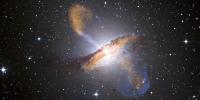(a) Estimate the mass of the luminous matter in the known universe, given there are
1011 galaxies, each containing
1011 stars of average mass 1.5 times that of our Sun. (b) How many protons (the most abundant nuclide) are there in this mass? (c) Estimate the total number of particles in the observable universe by multiplying the answer to (b) by two,
since there is an electron for each proton, and then by
109 , since there are far more particles (such as photons and
neutrinos) in space than in luminous matter.
